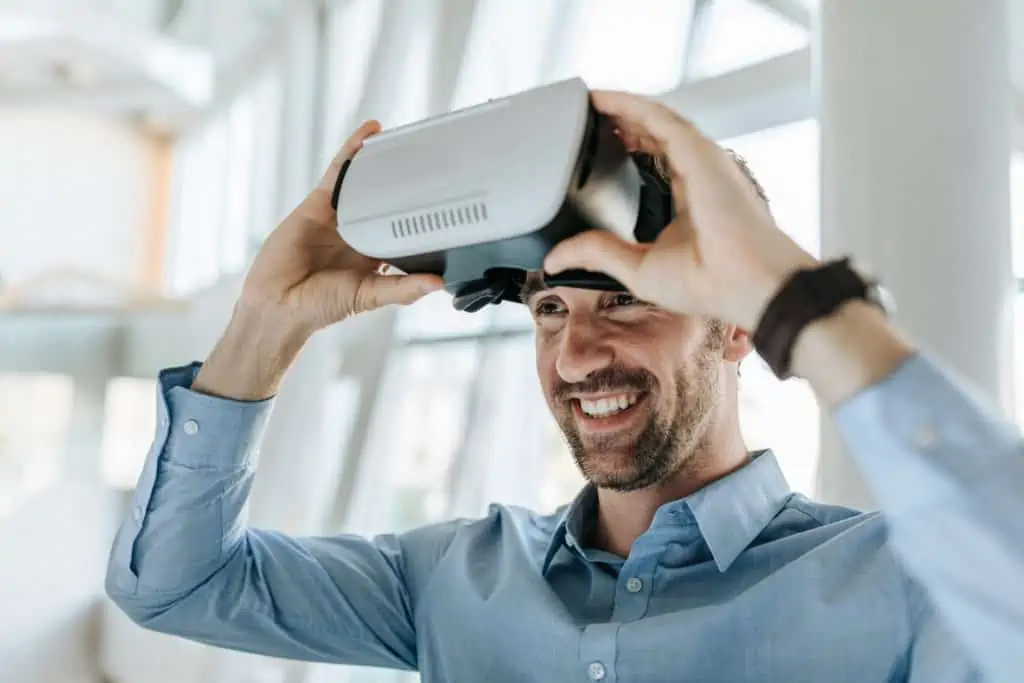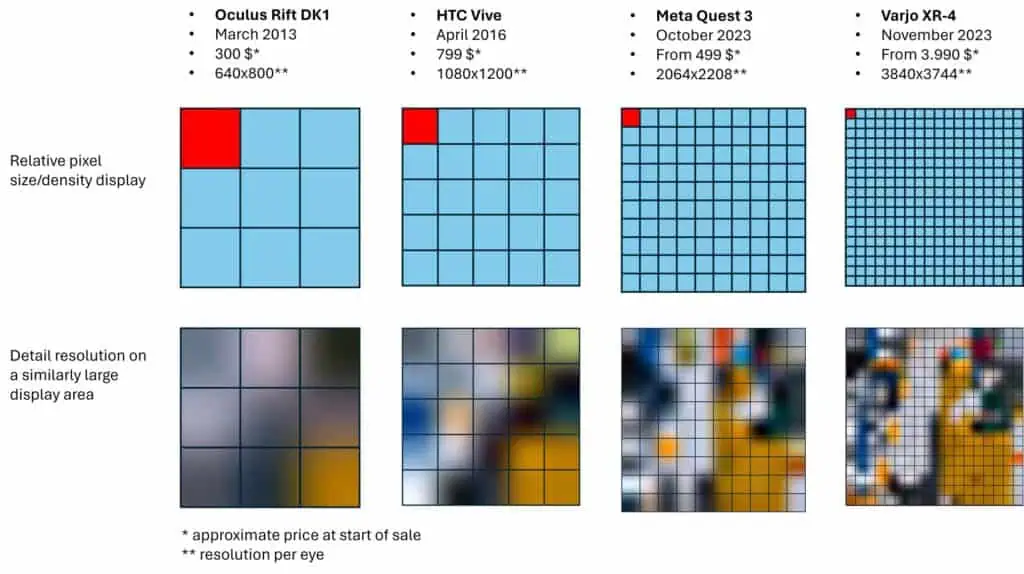
VR has arrived on the market! In the following article we will show you why virtual reality can be used in practice.
- The number of VR users continues to grow
- Current VR headsets offer comfort and high image quality
- The 3D factory arrives in reality
VR had developed so much from 2016 to 2020 that a trend had now become a boom. The number of pixels per eye has at least quadrupled in 8 years. Glasses are now also wireless and can even be used completely independently without a PC. We’ll show you why VR has arrived and that it’s never been easier to use a 3D factory model in VR.
1. Virtual reality entertainment industry continues to grow
Even though the VR boom of 2020 in the PCVR entertainment sector driven by AAA games like Half-Life: Alyx is over for now, the market continues to grow steadily, especially in the mobile sector thanks to Meta Quest. It should be noted that new, better VR glasses are constantly appearing, especially in the PCVR sector, but these currently only feature a few high-quality games. The reasons for this were, among other things, Meta’s departure from large PCVR productions, as well as the financially unsuccessful ports of well-known IPs such as Hitman or Medal of Honor. It feels like there are currently more glasses in the entertainment industry than high-quality games for them. Even if ambitious indie projects and established VR studios such as nDreams, Vertigo Games and Survios continue to produce new games.
Despite all this, based on the monthly users on Steam with a VR headset, it can be seen that the proportion of VR users has increased from a good 2% to just under 3% (as of April 2024). In the context of the current 90 million monthly users, this corresponds to approximately 2.5 million PCVR users. However, the Chinese market with its special conditions, which accounts for around a third, is excluded. The saying “VR is dead,” which is also often used by internet trolls, can be safely ignored
What makes the PCVR market special is, firstly, the huge variety of different VR glasses and possible PC configurations as well as the openness to software development. One can also speak here of a strong fragmentation of available software and hardware. This is a blessing and a curse at the same time. On the one hand, it is more difficult for developers to make their software run with all available headsets and PC configurations. But on the other hand, interesting developments continue to emerge. At the end of 2023, the so-called UEVR mod was made available to the general public by a hobby developer nicknamed “praydog”. This mod, developed over several years, allows almost any 3D game based on Unreal Engine version 4 or 5 to be made VR-capable. Many well-known and older games received unofficial VR support practically overnight, which increased interest in VR overall.
Of course, employees also take the enthusiasm from private VR experiences with them to their companies and look for possible applications. The entertainment industry therefore also serves as a driving force for the introduction of professional solutions.
2. Virtual reality hardware is getting better and better
The Meta Quest – still the most popular PCVR glasses
Even though Meta no longer produces games directly for PCVR, the Meta Quest is by far the most popular PCVR headset on the market on Steam. With a market share of 68% across all supported meta headsets, there is clear dominance and for good reasons.
The hardware is almost unrivaled in terms of performance and price. It is particularly popular because the Quest 3, like its predecessors, can be used wirelessly via WLAN. The tangle of cables that is usual with other VR glasses is no longer necessary. Using VR without cables also increases the Screen Door Effect (SDE), the immersion. A fairly high resolution of 2,064 x 2,208 per eye minimizes the so-called “fly screen effect”, which was even more clearly visible in the Quest 1 from 2018 (1440×1600 pixels per eye), for example. The following illustration shows a tiny section of a VR display. These usually have an image diagonal of approximately 3.5 inches (8.9 cm) per eye if there is an independent display for each eye.

The pancake lenses recently installed in the Quest 3 enable sharp vision across the entire lens surface and the glasses can be easily put on without the need for time-consuming alignment with the eyes. In practice, this is a big advantage over the Fresnel lenses that are still commonly used in other VR headsets with a small, so-called sweet spot. Meta also offers excellent software support with regular updates, easy commissioning and excellent inside-out tracking. However, you should avoid direct sunlight in order to achieve consistently stable tracking.
Mixed reality is getting better and better
The Quest 3 can also do mixed reality in color through the outward-facing cameras. The quality of the RGB passthrough is not comparable to Apple’s Visio Pro. But even a smartphone can be read quite well through glasses since Update 64. In AR applications, a user can orientate themselves very well and perceive their surroundings more naturally. Apps like Cubism also show how excellent the integrated finger tracking of the VR glasses works, which has been constantly improved over the generations.
The many possibilities of Quest 3
In addition to the extensive catalog of games and apps offered by Meta, your own applications from Unity or the Unreal Engine can also be loaded onto the headset using an APK file (Android package, installation file). This is also done via the Sidequest app, among other things, and thus supports completely autonomous use without a connected PC. Itch.io is another platform where developers offer demos and full versions of their projects. With the Snapdragon XR2 Gen 2, the headset also has a significantly more powerful processor on board than its predecessors. 3D models with several million polygons can now be displayed in VR on mobile devices. In the first generation there were a maximum of one million polygons with a very low refresh rate.
With all of these features, the Meta Quest 3 is still the headset with the most diverse options at a low price.
No problem, simply subscribe to our Blog-News!
Even more PCVR headsets – not an easy choice
In addition to the Meta Quest, there are many other VR headsets for the PC. Also worth mentioning is the Quest competitor Pico 4, which is also often used in conjunction with PCs. Also referred to as “TikTok glasses”, this platform is viewed rather critically with regard to data protection in connection with the Chinese manufacturer ByteDance. The HTC Vive Focus 3 also works wirelessly, but is more interesting for pure PC use. Other well-known headsets are the wired Vive headsets from HTC, Pimax, the Valve Index or the Windows Mixed Reality glasses HP Reverb G2. There are also exotic VR glasses for enthusiasts such as the Varjo Aero or Bigscreen Beyond. However, these cost many times more than Meta Quest 3 and are sometimes even tailored to a single user, as is the case with Beyond. A higher, native resolution automatically means higher demands on the PC that operates the VR glasses. A Varjo XR-4 with complex 3D visualizations is actually already created for the next generation of graphics cards. After all, almost 14.4 million pixels have to be calculated per eye at native resolution. On a Quest 3 there are just 4.5 million pixels. Many of these PCVR glasses are only operated stationary, as they require the so-called lighthouse trackers as additional hardware for tracking the glasses.
Windows Mixed Reality (WMR) will still be usable until 2027
The VR integration WMR for Windows 11, which was launched by Microsoft in 2017, was unfortunately discontinued by Microsoft at the end of 2023. If you want to continue using WMR glasses from September 2024, you should probably stay on Windows 11 version 23H2 and not update. Then Microsoft will allow operation until November 2027, at least for commercial users, and private use until November 2026.
Streaming VR content to the headset
Back to Quest 3. Using Virtual Desktop, Air Link or Steam Link, the headset can be operated without a cable or jokingly “without a dog leash” on a powerful PC with a 5 GHz capable WiFi 5 router and above. When configured correctly, the image quality and latency of the VR stream is so good that it can hardly be distinguished from an uncompressed signal via a DisplayPort cable. Speaking of powerful, today that also means laptops with a corresponding graphics card.
I’ve had the best experiences with VR streaming so far with Virtual Desktop. The tool developed by Guy Godin is stable, resource-saving and is probably one of the most important apps for Meta Quest users who want to use the glasses on the PC. The app even supports the new AV1 codec. It should be noted that compared to native PCVR headsets such as the Valve Index, more power is required for compression and decompression of the image signal and this results in an additional latency of a few milliseconds.
3. The 3D factory has become reality with VR
In fact, it has never been easier to use VR in factory planning. This works best when planning software has VR directly integrated. visTABLE®VR enables seamless opening of visTABLE® layout documents (vtlx) without the need to install third-party software or export data. Simply save the current layout and start the VR view. You can now walk through the virtual factory or even fly. Size relationships and distances are perceived correctly. This opens up better opportunities for communication within the company and supports decision-making processes in the planning of a factory.
Conclusion
VR is becoming increasingly suitable for the masses. The configuration and commissioning of VR glasses on a PC certainly always takes a little time and the appropriate know-how. But it has become increasingly easier over time, as SteamVR (Valve Corporation) and OpenXR (Khronos Group) are also constantly being further developed. There is now also an extensive knowledge base on the Internet. Manufacturers like Meta also make their headsets as user-friendly as possible. Resolution and image quality already correspond to ordinary work monitors or smartphones and sometimes even exceed them. Thanks to inside-out tracking and integrated graphics processors, VR glasses like the Meta Quest 3 can also be used completely independently. There is also a trend towards augmented and mixed reality. With Quest 3, Meta has increasingly ventured into this area of entertainment for the first time. This makes new applications possible and the age of spatial computing proclaimed by Apple is approaching.
The boundaries between reality and virtual space are becoming increasingly blurred and factory planning is also benefiting from this. Applications in this area can now be implemented in a user-friendly and cost-effective manner. visTABLE®VR also proves this.
No problem, simply subscribe to our Blog-News!



